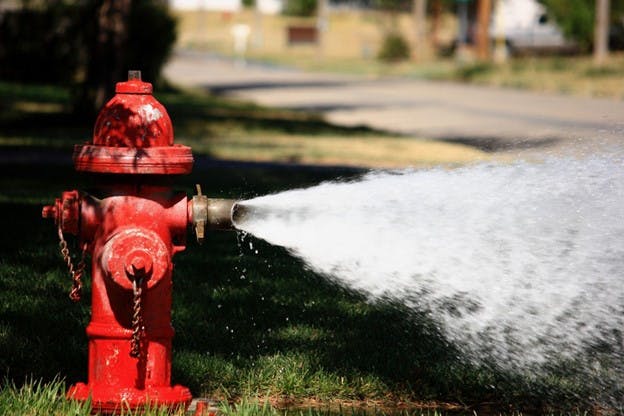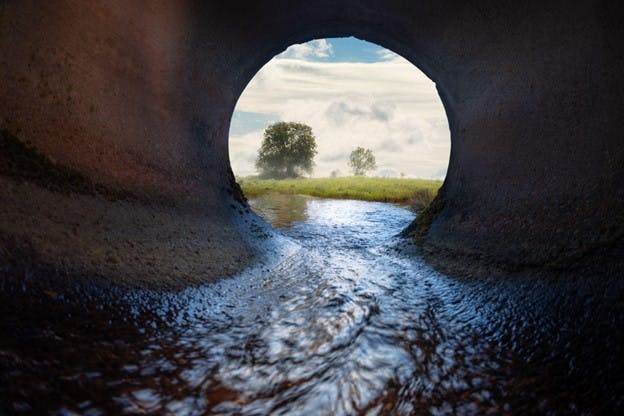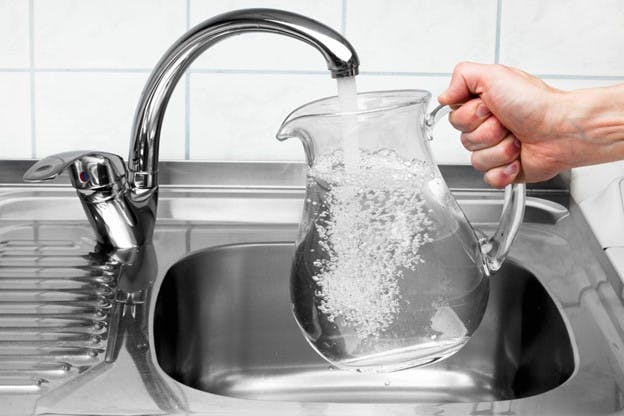September 2023
Water Pressure vs. Flow Rate: How They Interact
Who doesn’t enjoy having strong water pressure in their home? Those perfect, body-enveloping showers, toilets that flush easily, and the ability to quickly rinse the soap off your hands just make your day that much better. On the other hand, if you lose water pressure, every turn of the tap is a disappointment.
However, when we complain about low water pressure or praise high water pressure, we’re often really talking about the flow rate. Water pressure is the force with which water comes out of the tap, but water pressure means nothing if you’re not getting enough water. Remember those old transparent plastic water pistols? Tons of water pressure but not much water. Good luck washing your hair with one of those.
In this article, we’re going to explore the concept of water pressure vs. flow rate so we can better understand why they are both important and how they interact with each other to create your home water experience. We’ll also look at some possible solutions if you’re lacking either and even tell you when a lack of water pressure could be dangerous.
What Is Water Pressure?
Water pressure is how much force the water is exerting on the surfaces around it. It’s usually measured in pounds per square inch (PSI). The higher the amount of pressure, the more force the water will move through the pipe with. If you’ve ever stabbed through a juice box while squeezing too hard, you have some understanding of how water pressure works.
Water pressure can come from many sources. It can come from heat, like you might see when a hot-spring geyser erupts or if you use a pressure cooker. It can come from mechanical pressure like a pump. Or it can just come from gravity — think about the pressure you feel when drifting at the bottom of an eight-foot-deep pool.
Gravity can even create pressure strong enough to propel water from hundreds of feet below the surface of the earth in artesian wells.
When it comes to your home water pressure, it's usually controlled by either gravity or a pump system. You may also have a water pressure regulator as part of your home plumbing system. These regulators lower the pressure of water coming into your house to protect your pipes and appliances from damage caused by high pressure.
If you live in an area that uses water towers, you can thank gravity for that sweet water pressure you love. Instead of the eight feet of head-squeezing downward pressure you feel at the bottom of the pool, water towers deliver water pressure from 130-170 feet above you. The taller the tower, the more force it creates below when it flows down to underground water pipes and then makes its way to your house.
But what about flow rate?
What Is Water Flow Rate?
The flow rate or rate of flow is the amount of water that moves through a space in a given time. A busy river might have a flow rate of thousands of gallons per second. In your home, it's usually measured at a more modest gallons per minute (GPM).
Water flow rate is the unsung hero of the perfect shower experience. It's also pretty handy when filling a jug or anything else, really. If you have a generous flow rate, it makes having great water pressure much more likely. More water flowing can easily create stronger water pressure. If you have good water pressure, it's the flow rate that makes the difference between a satisfying shower and a sorry trickle.
Flow rate is usually affected by the diameter of the pipes that bring the water in. You can get a lot more water out of a firehose than a garden hose. But even a little goes a long way — the difference between a one-inch water line and one-and-a-quarter inch is about 75% more water coming into your home.
Water Pressure vs. Flow Rate: How Are They Related?
Water pressure and flow rate are interlinked. Thinking back to that firehose vs. the garden hose, if a firefighter tried to feed the volume of water they use through the garden hose, the pressure inside the garden hose would be so immense it would probably burst. But before it did, any water that made it to the end would likely shoot out with the speed and force of a pressure washer.
On the other hand, if you ran the amount of water that usually comes out of a garden hose through a firehose, the firehose would never inflate, so no pressure would build up against the inner walls of the hose to force the water toward the opening. Once it got to the end, it would just dribble out.
To get decent water pressure, there needs to be enough water flowing to create pressure against the inner walls of the piping system. The pipes also need to be unobstructed, so they allow enough water through to get a decent flow rate. A lower flow rate can lead to a pressure loss in the system and a disappointing trickle coming out of your showerhead.
Does Low Pressure Mean Low Flow?
Low pressure does not necessarily equal low flow. You can have lower flow but still have high pressure, like in our water pistol example. Likewise, you can have high flow and low pressure if the flow is not constrained enough to create pressure in the system — like sending a garden hose's amount of water through a firehose.
With that said, when it comes to water pressure vs. flow rate, one can lead to the other. Low pressure will decrease your flow rate because there’s nothing to drive the water forward, so it will just mosey along inside the pipes until it finds the faucet. And if your flow is blocked somewhere in your pipes, you may have pressure problems down the line.
Does Reducing the Flow Rate Increase Pressure?
Limiting the flow rate can sometimes increase water pressure, but not always.
If you put your thumb at the opening of a hose, the water becomes constrained, which builds pressure while at the same time cutting some of the flow of water. This is also the idea behind a showerhead — limiting the size of the openings for the water lowers the flow rate while increasing the pressure.
However, lowering the volume of water flowing through the pipes will have the opposite effect of constricting the opening. This is the difference between turning your faucet on full blast or turning it on just a little bit. The lower it is, the less water is coming through, and that means lower flow and lower pressure.
Does Increasing Pipe Size Increase Water Pressure?
Generally, a larger pipe can increase water pressure, but there are limits. Larger pipe diameters move more water, and this can create stronger pressure, especially if you have multiple faucets and appliances competing for water. But this only works up to a point. Just like the strength of a chain can only be as strong as its weakest link, your flow can only be as high as your plumbing system's narrowest length of pipe or fixture.
For instance, if your tap into the municipal water main is too small for your home’s water requirements, increasing the diameter of your pipes won’t increase your water flow because of the bottleneck of the small tap. This could even work to decrease your water pressure because your pipes could be too wide to allow adequate pressure to build.
The same could be true if you replace your supply lines with wider pipes but your home plumbing is too small or clogged up. You won’t get more water flow or more pressure unless everything is the appropriate size for your home.
What Can Cause a Water Pressure Drop?
In the battle of water pressure vs. flow rate, there are many things that can cause a water pressure drop in your home. Here’s a checklist that could help you find the root of the problem:
- Is your water filter well maintained? If your filters are old and in need of a change, it could slow your water flow.
- Do you have a leak or water running elsewhere? Only so much water is coming into your home. If someone left the hose on or a toilet in the basement is running, it could be hurting your water pressure.
- Is your hot water heater a problem? Hot water heaters can gunk up, especially if you have hard water. Is your cold water running stronger than your hot water? Your heater may be the problem.
- Is air trapped in your water pipes? Do you hear knocking in the pipes? If so, there could be air trapped in them, and you may need to flush your system.
- Are your pipes and fixtures clogged? Do you have hard water? Hard water minerals can build up in your pipes and restrict your water flow. Start by investigating your aerators. If those are clogged, clean or replace them. Then consider a salt-free water conditioner to help to clean out your pipes.
- Is your water shutoff valve fully open? If you’ve had recent work done, make sure your shutoff valve is fully reopened if you could have a low flow coming into your house.
- Is your water pressure regulator working properly? Many houses have a water pressure regulator. If it’s reading wrong, you may not be getting the right amount of water. Check this with a pressure gauge to see if the regulator needs to be replaced.
- Are your neighbors experiencing the same problems? If you get your water from a public water system, low pressure could be a system problem. If your neighbors are having a similar problem, contact your water supplier immediately and avoid drinking the water until you get the all-clear — drops in water pressure are one of the biggest causes of boil water advisories.
Check out our guide to low water pressure in your house for a deep dive into the topic if you're struggling with your home water pressure.
Is It Safe to Drink Water If the Pressure Drops?
If your pressure drops, it’s prudent to check with your water company to make sure there’s not a boil water advisory in effect. Water pressure inside the public water main helps keep contaminants from seeping into the pipes. If the pressure drops in the water mains, they may issue a boil water advisory until they can ensure there has been no dangerous contamination of the water supply.
Clean Water and Clean Pipes Make Everything Better
Understanding water pressure vs. flow rate can improve your quality of life. Having taps, pipes, and fixtures in the appropriate sizes for your home — and keeping them clean through proper water filtering and softening — can make the difference between blissful showers and frustrating dribbles.
HomeWater water filters, softeners, and salt-free water conditioners help keep your pipes clean and flowing, and they are designed to have a high flow rate themselves.
Our HomeWater EZChange 2-Stage Under Counter Under Sink Water Filter reduces chlorine, lead, rust, dirt, and particulate matter, leaving you with nothing but great-tasting water. And with a generous flow rate of one gallon per minute, it's sure to keep you going with the flow.
Want to find the best water filter for your house? Take our quick filter quiz!


